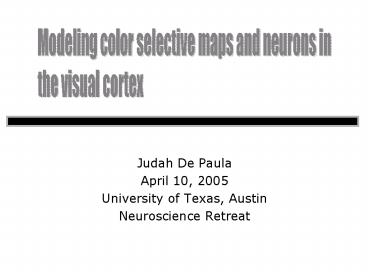Judah De Paula - PowerPoint PPT Presentation
1 / 19
Title:
Judah De Paula
Description:
Color Processing in the Macaque Striate Cortex: Relationships to Ocular ... organized representation of colour in macaque cortical area V2. Nature 412:535 ... – PowerPoint PPT presentation
Number of Views:502
Avg rating:3.0/5.0
Title: Judah De Paula
1
Modeling color selective maps and neurons in the
visual cortex
- Judah De Paula
- April 10, 2005
- University of Texas, Austin
- Neuroscience Retreat
2
(No Transcript)
3
(No Transcript)
4
Why study color vision?
- Understand how the brain can organize complex
stimuli - Color is an integral part of vision
- Robots will need color to interact with humans
- Help understand color blindness in human patients
- How does color increase salience?
5
Overview
- Introduction
- Biology
- Model
- Results
You are here
6
Vision physiology in the retina
- Rods not used in daylight
- Fovea consists of cones
- Cone wavelength sensitivity functions overlap
each other - Only Long (Red) and Medium (Green) wavelength
cones found in fovea.
7
Vision Anatomy
- Retina LGN Primary Visual Cortex
8
V1 Optical Imaging (Landisman et al.)
Macaque monkey, Landisman and Tso
1mm
A Color selectivity map B Orientation map C
Color map with orientation pinwheels D
Orientation map with pinwheels and color map
overlaid
9
V1 Optical Imaging (Landisman et al.)
- How are these maps created in the cortex?
- How do the color, orientation, and O.D. maps
interact? - Landisman suggests ocular dominance is more
related to color than orientation maps. Is this
generally true?
10
Color Opponent LISSOM
- Each Cell Type in the LGN is represented with a
separate Sheet between Photoreceptors and V1 - Each Sheet has a receptive field with a different
Gaussian function - LISSOM adjusts for different numbers of LGN
Sheets - Works with natural images
Bednar, De Paula, Miikkulainen. 05
11
Cone type distribution
- Random distribution of cone types. No S-cones in
fovea - Ratio between L-M differs between patients 0.251
to 91 without loss of color selectivity
(Brainard et al. 2000)
Lennie, 2000
12
Color Opponent LGN cells
Existing Model
- Lateral Geniculate Cells
- Long Center / Medium Surround
- Medium Center / Long Surround
- LM Center / LM Surround
- Add S Center / LM Surround
Red-Green L / M-
Luminosity (ML) / (ML)-
Green-Red M / L-
Blue-Yellow S / (ML)-
Proposed
13
LISSOM Model
LISSOM ? Laterally Interconnected Synergetically
Self-Organizing Map (Sirosh,
Choe, Bednar, Miikkulainen 93-04)
14
Modeled orientation preference in V1
- Patches develop for each orientation
- Similar to animal maps
- Some areas not orientation selective (White
regions)
Bednar, De Paula, Miikkulainen. 05
15
Modeled color preference in V1
Color preferring regions found with solid-field
test stimuli
Bednar, De Paula, Miikkulainen. 05
16
Orientation/Color overlay
Color selective blobs (outlined) match to OR
unselective regions
Bednar, De Paula, Miikkulainen. 05
Completed work similar to Cytochrome Oxidase
blobs observed in biological V1
17
Discussion
- Uses for a cortical model of color vision
- Computer Science robotic vision
- Neuroscience mechanism for organization
- Psychology origin of perceptual experience
- Add short cone opponent cells to LGN for
trichromatic vision - Add V2 region
- Test for functional stripes
- Test for Hue organized color selectivity
18
References
- http//www.phys.ufl.edu/avery/course/3400/gallery
- http//webvision.med.utah.edu/Color.html
- Miikkulainen, Risto and Bednar, James A. and
Choe, Yoonsuck and Sirosh, Joseph (1997)
Self-Organization, Plasticity, and Low-level
Visual Phenomena in a Laterally Connected Map
Model of the Primary Visual Cortex, Psychology of
Learning and Motivation, volume 36 Perceptual
Learning, pp. 257-308. - Kandel, Schwartz, and Jessell. Principles of
Neural Science Third Edition 1991. - James A. Bednar and Risto Miikkulainen (2003).
Self-Organization of Spatiotemporal Receptive
Fields and Laterally Connected Direction Maps,
Neurocomputing 52-54473-480. - http//www.brainfiber.com/flowers.jpg
- Lennie P. 2000. Color vision putting it
together. Curr. Biol. 10(16)R589-91 - Landisman, Carole and Tso Daniel. Color
Processing in the Macaque Striate Cortex
Relationships to Ocular Dominance, Cytochrome
Oxidase, and Orientation. - Kandel, Schwartz and Jessell. Principles of
Neural Science. McGraw Hill. 2000 - Shipp and Zeki. The func. org. of area V2, II
The impact of stripes on visual topography. Vis
Neurosci. Iss. 19, 211-231. 2002. - Sincich and Horton. Pale cytochrome oxidase
stripes in V2 receive the richest projections
from macaque striate cortex. J. Comp. Neuro.
44718-33 - Xiao and Fellerman. Projections from primary
visual cortex to cytochrome oxidase thin stripes
and interstripes of macaque visual area 2. PNAS
1017147-7151 - Tootell, Nelissen, Vanduffel and Orban. Search
for Color Center(s) is Macaque Visual Cortex.
Cerebral Cortex 2004. 14353-363. - Clarke, Walsh and Schoppig. Colour constancy
impairments in patients with lesions of the
prestriate cortex. Exp. Brain Res. 123154-158 - Xiao, Wang and Fellerman. A spatially organized
representation of colour in macaque cortical area
V2. Nature 412535-539
19
Red-Green Receptive Field Spike Trains
Adapted from Kuffler, 1953































